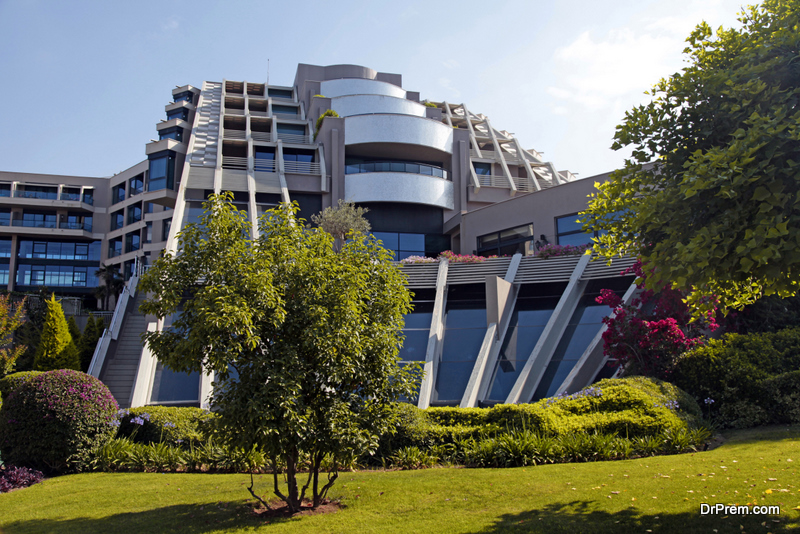Let’s take a moment to imagine two scenarios. In the first, you stroll past a commercial building surrounded by grey pavement and parked cars. In the second, you walk by a commercial fabric building enveloped by lush green plants, trees swaying in the breeze, and the gentle hum of bees. Which feels more inviting? If you’re like most of us, the second image is likely more appealing. This illustrates the power of green landscaping, especially around commercial areas. So, why is it so important?
The Rise of Green Infrastructure
Over the past few decades, we’ve witnessed rapid urbanization, leading to concrete jungles that sometimes make cities feel sterile and disconnected from nature. Because of this, our cities started facing problems like more pollution, extra heat, and people not feeling too well.
So, people thought of a new idea: Why not mix nature back into the city? This idea is called green infrastructure. It means adding more plants, trees, parks, and even things like green rooftops to our cities. Instead of just thinking about buildings, we’re now thinking about how we can make our cities feel more like big gardens where people live and work.
Advantages of Green Landscaping
But, what is the role of green gardening? There are more benefits to green gardening than just aesthetics. Imagine living in a place where the air is pure, where the peaceful effect of nature drives up property prices, and where runoff is organically filtered and absorbed. This is the potential of green landscaping. Each tree, shrub, or patch of grass serves a purpose, whether it’s providing habitat, reducing soil erosion, or simply giving our eyes a break from the relentless urban grey. Let’s check the benefits in detail.
1. Improving Aesthetic Appeal
Let’s face it; a building surrounded by greenery is simply more attractive than one without. The lush green contrasts beautifully with the modern designs of commercial fabric buildings. Nature adds an element of tranquility and beauty, making the structure stand out and inviting people in.
2. Championing Sustainability
The primary reason for incorporating green spaces around commercial buildings is sustainability. With the adverse effects of climate change becoming increasingly pronounced, businesses are recognizing the importance of playing their part in promoting environmental health. Green landscapes act as lungs for urban areas, absorbing carbon dioxide and releasing oxygen. They also aid in water conservation through natural filtration and ground absorption. Plus, the introduction of native plants fosters local biodiversity, creating pockets of ecosystems even in heavily urbanized areas.
3. Prioritizing Health and Well-being
More than just beautifying spaces, green landscapes have a direct impact on health and well-being. Nature reduces stress and heals people not only emotionally but also physically. Whether it’s a break from screen time or just a breath of fresh air, green spaces around commercial buildings provide employees and visitors a chance to rejuvenate.
4. Realizing Economic Benefits
From a business perspective, green landscaping offers tangible economic benefits. A well-landscaped commercial property can command higher rents or property values. Moreover, greenery provides natural insulation and shade, potentially lowering energy costs, especially during peak summer months.
5. Fostering Community Engagement
Remember those days when community members gathered under large trees or in local parks? Green spaces are magnets for community activities. Green spaces, with their benches, pathways, and open areas, serve as communal spots ideal for gatherings and recreational activities. They can host lunch breaks, team meetings, or even corporate events, making businesses more integrated with the community.
6. Offering Functional Benefits
Apart from aesthetics, landscaping serves functional purposes. Trees and shrubs can act as natural barriers, reducing noise pollution. Furthermore, green areas effectively manage stormwater, preventing flooding during heavy downpours.
7. Mitigating the Urban Heat Island Effect
Anyone who’s walked on a scorching pavement during summer understands the heat generated by urban areas. This phenomenon, known as the Urban Heat Island effect, can make cities significantly hotter than their surroundings. However, green landscaping can help mitigate this, providing natural cooling.
8. Envisioning Cities of the Future
Lastly, as urban planners and architects envision the cities of tomorrow, the integration of green spaces within commercial areas is crucial. It’s a step towards a more balanced coexistence between urban living and natural ecosystems.
Green landscaping around commercial fabric buildings is not a mere architectural trend, it’s a movement. It represents a conscious shift towards sustainable, aesthetic, and functional urban planning. As commercial areas continue to evolve, one can only hope that the marriage between green and grey becomes even more harmonious.
Among modern architectural choices, commercial fabric buildings stand out. They’re not just visually appealing, but they bring a host of advantages to the table. Their flexible design ensures they can adapt to various terrains and requirements. Durability ensures longevity, and their cost-effectiveness makes them a top choice for businesses. But what truly sets them apart is their compatibility with green landscaping. Their design seamlessly integrates with green infrastructure, ensuring a building that is both functional and in harmony with its surroundings.
Challenges and Solutions
Indeed, green landscaping is not without its challenges. Space constraints in densely populated cities, high maintenance costs, and potential conflicts with existing infrastructure are genuine concerns. However, with technological advancements, community participation, and innovative design solutions, these challenges can transform into opportunities for growth.
The move towards integrating green landscaping around commercial fabric buildings signifies a broader shift in our societal values and priorities. It’s not just about aesthetics or ticking a box for sustainability. It’s a profound acknowledgment of the interconnectedness of all life and a commitment to building cities that nurture, rather than negate, this connection.
Article Submitted By Community Writer




